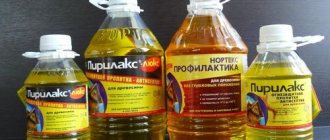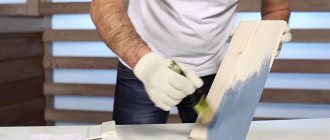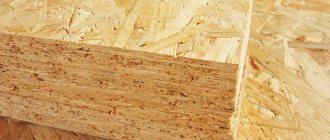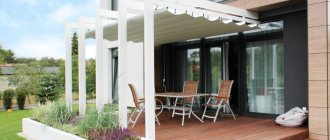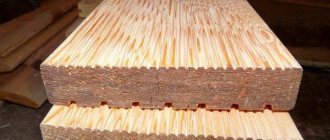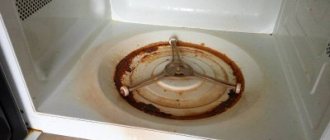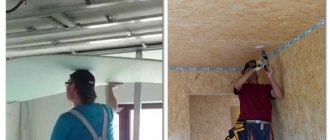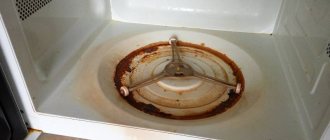All about painting lining
Why is this necessary
? How can you paint?
- Protective drugs
- Decorative processing
How to paint
Why process and paint lining
Any wood material must be coated with protective compounds. Without them, the finish will quickly lose its appearance and become unusable. Paints, varnishes and impregnations perform several functions:
- Improves the appearance of the front surface of the lining;
- Prevents natural darkening of wood;
- Protects against mold, mildew and rot;
- Reduces the release of resin from coniferous trees;
- Improve water-repellent properties, thereby preventing swelling and deformation;
- Reduces the ability to ignite and spread fire.
Different types of coatings solve one or more problems. Therefore, for the best protection, you have to choose several compounds at once. How to paint the lining inside the house depends on exactly what functions are assigned to the coating and what appearance of the finish you would like to achieve in the end.
Preparatory stage
If the decision is made, you need to clearly understand the style and method of painting the lining in the required color. There are three main types of painting that are applied to wood:
- Protection with colorless varnish;
- Darkening of wood, antique decoration;
- Complete painting of the slats in an unnatural color.
Depending on the chosen option, the preparatory stage will contain a different set of tools, paint application techniques, and type of paints and varnishes.
What these stages have in common is the application of protective mixtures to the lining itself. As a rule, even at the factory, treated boards are coated with antifungal mixtures. However, upon arrival of the materials at the site of repair work, the wood must be re-coated with a primer and additional means: fire-fighting mixtures, antiseptics, etc. The key agent will be the primer - without it, the adhesion of paint and varnish mixtures to the wood may be insufficient, which means the life and quality of the coating service may decrease.
Painting lining: relevance of the issue
We can talk for a long time about the advantages of wood as a finishing material. It is characterized by the ability to heat and sound insulate, and the ability to visually hide unevenness of the surface being finished, and ease of installation, and, of course, durability. Thus, lining is characterized by all the advantages inherent in wood. However, wood also has its own disadvantages, such as a tendency to catch fire, rot, and be susceptible to damage by insects and fungi. In this regard, despite the fact that lining is a durable material, over time it loses its original characteristics. To avoid this, wooden finishing materials must be properly maintained, one of the stages of which is painting the wooden lining.
Important! Painting the lining is the final stage of finishing activities, however, it, as well as the implementation of other stages, must be approached with due responsibility. The service life of the lining and its ability to maintain its original performance characteristics depend on the selection of the most effective paint and varnish composition.
Lining photo
Types of painting materials
How to paint the lining? Answering this question can be quite difficult. The fact is that there are many compositions that differ in their characteristics. Their correct use can transform the room or, conversely, ruin the entire appearance.
Protective compounds
These solutions act as protectors, but can provide a certain decorative effect.
Fire retardants
It is necessary to coat products with such a composition that are located in places where fire may occur. Of course, it is better to impregnate all wooden materials used in finishing work.
On a note! It is very difficult to apply fire retardants with your own hands; the effect is not so significant. Therefore, preference should be given to elements that are processed in production.
Antiseptics
Substances that eliminate the threat of various types of bacteria that contribute to rotting and destruction. This solution is perfect when you want to leave the material unchanged. The composition will protect the product for a long time, so it will not require additional painting.
Antiseptic protects the lining from various bacteria
Lucky
In fact, varnishes are already closer to paint compositions, but they have a good protective function. Painting the lining inside the house can be done with different materials:
- Acrylic lacquer. Great for all interior spaces. It can be transparent or translucent. If necessary, the substances can be tinted.
- Synthetic materials. This option requires caution. At dachas they cover the rooms that are located at the entrance to the house.
It is quite easy to work with varnish compositions, you just need to take into account that to achieve a better result you need to apply them in several layers.
Varnish allows you to protect the lining from rotting, damage and destruction
On a note! An excellent solution can be wax, which protects the elements and gives them a rich shade. But it is quite difficult to apply, because you have to literally rub it into the surface.
Linseed oil
Natural water-repellent impregnation. Penetrates deep into the structure of wood, tightly seals natural pores. Thanks to this, moisture loses the ability to absorb into the material and destroy it. Microorganisms do not survive in such conditions, so flax oil has a double effect. In addition, it gives the wood a light tint, clearly highlighting its texture.
Bleaches
Removes stains of various origins. Apply to the base for a short time and then wash off with water. They are not painted white, but the material is prepared for further finishing.
Drying oils
Preparations made from natural or synthetic oils. There are combined options. Penetrate inside the lining plates and protect it from moisture. They shade the structure a little. Over time, oiled surfaces become noticeably yellow and sticky.
Waxes
Compositions with an effect similar to varnish. They tint the wood and give it a noble semi-matte shine. Available in different forms. Liquid and water-based waxes are ready to use immediately. Solid ones need to be heated. The main problem is the difficulty of applying wax to the surface. It lays down unevenly. This can be corrected by pre-treating the base with a primer.
Antiseptics
They contain bactericidal substances that prevent the development of microorganisms and insects. Thanks to this, antiseptics prevent the formation of mold, mildew, etc. Moreover, they are successfully used even after signs of infection have appeared. The disadvantage of all preparations is gradual weathering, so the surface must be treated regularly.
Available in the form of independent or complex products. The first are colorless, the second are colored. They change the natural color of the wood to the tone chosen by the owner. In addition, they form a film that protects the wooden base from moisture.
Decorative products
Painting wooden lining with a decorative coating means that the natural color of the wood will be lost. This is usually done after a certain time, when the unpainted wood darkens, or the owners have other creative ideas.
How to paint the lining inside the house? There are many different decorative coatings that meet the tastes of even the most demanding aesthetes. These include:
- Oil paint is a long-term recognized leader in the field of materials for painting wood. It is deeply absorbed inside, thanks to which the painted surface receives reliable protection. It doesn't fade for a long time. The main disadvantage is that the paint takes a long time to dry and has a strong, specific smell. Therefore, it is recommended to carry out repair work in warm weather so that the room can be ventilated.
- Acrylic paint is better than the previous one in all respects. Acrylic paint dries quickly and does not have a strong odor, which makes it possible to carry out work at any time convenient for you. This paint for lining does not fade for a long time, maintaining its original shine, and has good resistance to moisture. The only downside is the high price.
- Acrylic aqualacs are, by all accounts, the best means for processing lining. They are an environmentally friendly product. The varnish forms a reliable decorative coating that is durable, resistant to moisture and mechanical stress.
- Alkyd varnishes - painting the lining is the main function of this type of material. Its advantages are resistance to moisture and temperature changes. Significant disadvantages are long drying time, easy flammability, high price.
- Decorative glaze – thanks to its transparency, it perfectly highlights the wood texture. To give it the desired color, you can add different colors inside.
- Opaque enamels - creates a dense layer on the wood surface, completely hiding all defects and protecting the product from mechanical damage, well suited for country houses.
We recommend: How to conclude an agreement with a real estate agency
Oil paint
It is considered one of the most popular substances. This option has been used for many decades. This is because the solution has excellent characteristics. They consist in the fact that the composition penetrates deep enough into the upper layers of wood, ensuring its long-term preservation. The coating retains its properties for 7-10 years.
Some disadvantages cannot be excluded:
- The material has a rich chemical smell that takes a very long time to dissipate.
- The first point leads to limiting the dyeing time. That is, it is not possible to work in winter, because thorough ventilation is required, which can defrost the entire country house.
- The protective property of paint is fraught with another drawback - the material firmly clogs the pores of the wood, it stops breathing. This means that the microclimate, which is especially valuable when using lining, will be spoiled.
Therefore, this composition is used extremely rarely for interior work.
Stains
They are specialized liquids based on water or organic solvents that can penetrate deep into the wood, creating a certain color shade. Stains are also called "stain" - this is a foreign term. The products in question are not intended to protect the carriage. They can only tint it, although more functional products with a noticeable protective effect can be found on sale, but they are more expensive.
Often dark spots appear on wooden boards, the formation of which is not always clear. It is permissible to treat such areas with bleach, but to do this you need to choose the concentration and exposure period wisely. It is worth testing the composition on lining waste to see how the material behaves and changes.
Lucky
They are characterized by an excellent protective effect on wood. They are allowed to be used for lining lining in a private or country house. These same compounds are used to give the finish a more attractive appearance. Varnish solutions based on acrylic can decorate the surface of the lining, as well as form a special barrier on it.
The special aqualak has a minimal level of allergenicity.
It can be safely used for processing wood inside a building. This composition takes longer to dry than organic liquids, but is safer for the health of household members. With the help of aqualak it will be possible to create either a completely or slightly matte, glossy surface of the cladding.
If you add the color you like to the solution in question, the result will be a coloring agent of a certain shade. On the outside, such a composition will not be able to last on the cladding for a long time, therefore it is not recommended for street application. Water-based varnishes form a barrier to steam.
Other varnish compositions contain components designed to protect the base material from exposure to ultraviolet rays. It makes sense to use such options to treat surfaces that are exposed to the sun for most of the day. Alkyd varnish composition has good durability. After drying, the coating can remain on the material for more than 10 years. It is often recommended to treat the floorboards inside a wooden country house using similar means. Fans of interesting color schemes also apply alkyd solutions to the walls of their homes.
Fire retardants
The lining that is installed in the interior of a country house may be located in close proximity to heating systems and heating devices. In this case, it is important to properly protect the wooden finish from possible fire. Special flame retardant impregnations are ideal for this. When applied independently, they may not be the most “pliable”.
It is easier to purchase a lining for your dacha that is initially impregnated with the compounds in question. In rooms where the moisture concentration is no more than 70%, the material can be treated with moderately stable solutions. In the interior of a home, such compositions will last for a long time and are cheaper than weather-resistant options.
Acrylate paint
It should be immediately noted that this type is very similar to acrylic compositions, but has a lower price and the necessary characteristics.
This coloring option has the following properties:
- There is no unpleasant odor that requires long-term ventilation.
- The coating is much more elastic, which increases service life. It more successfully withstands an aggressive external environment. This is very important, because many country houses are left without heating during the winter.
- The surface remains breathable, which allows you to maintain exactly the atmosphere that is inherent in wooden structures.
- The work is done much faster and easier.
Acrylate paint allows you to create an elastic, breathable coating.
Of course, such material costs a little more than oil paint, but the result exceeds all expectations.
On a note! To paint the walls from the inside of the house, other options are used, which contain the mark “for woodwork” on the label. One of these varieties is stain. This is an excellent composition that allows you to saturate the wood with depth, but preserve its color and texture.
Acrylate paint for woodwork
Acrylic water-based translucent paint
Forms a thin layer on the surface of the wood, through which the texture and natural shade of the wood are visible. Such paints hide minor finishing defects.
Translucent paint on lining
Choosing a coloring agent
Painting of the lining is carried out using:
- oil paints;
- acrylic paints;
- acrylic aqualacs and alkyd paints and varnishes;
- antiseptic.
The lining can be coated with oil paint, which is suitable for both interior and exterior work.
Paint for lining can be oil-based, as we noted. It absorbs perfectly into the wood. Moisture usually does not pass through it; precipitation is not a problem for oil paint on the street. But the color may fade over time; another drawback is that it takes a long time to dry. Therefore, if the material was covered with dark paint, it will quickly fade.
As for acrylic paint, it also withstands all precipitation well, but its color does not fade over time. In addition, the surface will not lose its ability to pass air. Such paints allow steam to pass through, have elastic properties, and do not crack.
Scuba tanks are usually used inside the dacha. After all, they are environmentally friendly and hypoallergenic. Alkyd varnish is used for painting floors, since the coating material is hard and can withstand heavy loads. True, after ten years, wood coated with such a paint and varnish material will need to be repainted.
Oil based paints
A classic, proven method for treating walls outside the house. Oil paints have the following advantages:
- absorb into the surface, guaranteeing protection against moisture penetration;
- resistant to temperature and humidity changes.
Painting of this type also has some disadvantages, which are often not considered significant, rather falling into the category of the natural state of affairs.
- The compositions dry for a very long time - from 8 hours to several days. Therefore, sticking midges and dust contamination are possible. In addition, there is a risk of precipitation and changes in the surface of the paint due to exposure to water.
- Over time, the paint surface becomes dull and the color changes. This is especially noticeable for the extreme segments - dark and light color shades.
However, in general, oil-based paints are very functional. They are cheap, do not require special application methods, retain their characteristics for quite a long time, and almost everyone can paint using standard methods.
Oil paints are a traditional medium for coloring.
Why is impregnation needed?
Some owners of private houses do not see the point in treating the surface of the lining with impregnations. In fact, if thin planks are not covered with anything, after a certain period of time, not the best changes will appear on them. If there is insufficient ventilation, the fitting will become covered with a peculiar blue color, and if it is intensively exposed to aggressive sun, it may become dark gray.
The blue discoloration on the lining is caused by the action of microorganisms, which can be eliminated with the help of special oxidizing agents, for example, chlorine.
The procedure will not be the easiest or fastest, and will be accompanied by characteristic unpleasant odors. If a grayish coating has appeared on the lining due to exposure to sunlight, then you can get rid of it by turning to mechanical grinding. But the positive effect of these procedures is unlikely to last for a long time. It is more advisable to resort to processing the finishing material immediately after its installation. In this case, problems can be avoided in the future.
Impregnations suitable for lining not only protect it from negative external factors, but also make it more aesthetically attractive. With this addition, the interior looks nicer and neater.
Lining that has a waterproof treatment will last much longer, even if it is in a damp or irregularly heated room.
Features of applying impregnation
Lining is divided into several types. Different materials differ from each other in the number and structure of joints. Based on these parameters, a different amount of effort is required for its quality preparation.
When performing work, you must adhere to certain rules.
- Before treating the lining with any of the acceptable compounds, you must carefully inspect all the boards. If there are dark spots on them, you will have to resort to local lightening with bleach.
Recommended: Essential knowledge about mosquito nets
- Next, you will need to rinse the entire surface a little using a diluted soda solution. You will need to wait for the water to completely evaporate. Only after this can you begin to treat the lining with soil and the main solution or immediately with impregnation.
- Cracks must be sealed with putty. The surfaces will require sanding.
- To make the decorative layer stick better, the lining can be primed. The soil must be distributed especially carefully along the seams. To apply the selected primer mixture to the main part of the finishing material, you can use a convenient spray gun, but in places where there are joints, it is best to work only with a brush.
Impregnations with a specific function
Modern sellers of paints and varnishes are ready to offer their customers a large selection of different impregnation options. These compositions differ from each other, depending on the purpose for which they are intended.
Pinotex Ultra will create comprehensive protection for wooden panels
- Use of fire retardants. These substances can significantly reduce the level of fire hazard of the processed material. Accordingly, treatment with a fire retardant compound is a prerequisite for extending the life of the lining, as well as for ensuring safety.
It is important! It is customary to apply the fire retardant under special pressure; accordingly, it is desirable that such a composition be applied at an industrial level. Only this will allow you to get a more thorough effect than if you apply fire-reducing paint yourself.
- Compositions against bacteria. With the help of such impregnations, you can protect the lining from various types of rotting, contamination, as well as from damage by fungi and bacteria. It is worth noting that for the treatment of internal walls, coatings with a special mark are required. This will allow you to choose a harmless option that is water-based;
- Water-based acrylic varnishes. Their use is suitable for finishing lining when it comes to covering the inside of a house. Using acrylic you can achieve not only a purely aesthetic effect, but also protect wooden panels from external influences.
Apply acrylic varnish in two steps:
- Step 1 – applying a transparent base, which is a must if you are looking for how and what is the best way to paint the lining inside the house;
- Step 2 – direct addition of color, this is possible if you use a special tinting mixture. Here you can choose absolutely any shade, depending on your preferences.
Coating the lining with a layer of tinting mixture
- Synthetic based varnishes. They are more toxic than acrylic varnishes, which are based on water. However, using synthetics you can achieve the smoothest surface and shine, since they contain certain substances. Among them are toluene and xylene. The presence of these substances in impregnations of this type allows them to be used exclusively for external work, due to their too high toxicity and harmfulness to the residents of the house;
- Wax compounds. These materials for covering lining are an excellent replacement for varnish. With their help, they provide not only their characteristic semi-matte shine, but also excellent protection for wooden panels. However, it will be difficult for a non-professional to apply this composition; it is advisable that only an experienced technician do this.
Simple Methods
The simplest and most common methods of painting lining outside a house include staining. With its help, you can achieve not only protection from various adverse factors, but also create various artistic effects.
In addition, today you can find stain of any color, so the method can be compared with the use of colored translucent impregnations. This method is one of the simplest and cheapest, but its main drawback is the fragility of the coating. It is better to update the appearance of the walls outside the house once every year or two.
As you can see, high-quality painting of the exterior of the house is affordable and quite easy to implement with due diligence and care. Modern formulations can provide different protection properties, and the market offers a variety of color shades. Therefore, if you want a great looking house, just make it like this.
https://youtu.be/1uRf3OwjSwU
Preparing the lining for painting
If a coloring agent is selected, the surface of the panels should be properly prepared. The quality of painting depends on the quality of preparation, so this stage is very important.
To work you will need:
- pumice;
- clean rag;
- paint brush;
- primer.
Step 1: Clean the panels
First, wash the liningCleaning the surface of the lining
First, you should clean the lining from dirt. Take 5 liters of warm water, dilute 150g of soda in it, and then wash the entire surface with the resulting solution. For better adhesion of paint to wood, it is recommended to completely remove the previous layer of coating, especially if there are peelings and cracks. To facilitate this process, you can use a hair dryer and a metal spatula: the coating is heated with a hair dryer, after which the paint layer is easily lifted with a spatula. There are also special liquids in stores: apply a little product to the surface, wait for the time indicated on the package, and then rub the lining with a stiff brush and rinse.
Old oil paint can be removed using a piece of foil and an iron: the foil is applied to the surface, slowly ironed and the layers of paint are removed with a spatula within 20 seconds. After cleaning, carefully inspect the entire lining: remove mold stains, treat darkened areas with special bleaches. Finally, wipe the boards with a clean cloth to remove even the slightest bits of paint and dirt. If there are damaged panels, they should be replaced.
Step 2: Sanding
Grinding
Clean lining must be carefully sanded, and pumice or fine-grained sandpaper is best for this. In order not to miss a single section when sanding, it is recommended to divide the skin into small squares and process them sequentially. You should not press hard on the surface of the panel or rub one area for a long time; you should sand as evenly as possible.
Useful tips for painting lining
Step 3: Priming
Padding
After sanding, the lining is wiped from dust and a primer is applied with a brush or spray gun, carefully treating the seams between the boards. One coat of primer will be enough. Very often, the surface is primed with the same composition that is intended for painting.
Useful tips for beginners
Painting lining requires a continuous process. In addition, you should not apply a layer of varnish or paint twice to the same area of the lamella. Uniform application and continuity of the process are the key to long service life of the coating.
If the first time it was not possible to achieve the required shade, the lining can be painted again (only after the previous layer has completely dried). It is important to paint over problem areas of the lining: lock joints, cut points, board defects.
There is no clear answer to the question of the most suitable tool for applying paint. For “Calm” type lining, you can use a regular roller, since there are no joints between the locks. For embossed lining, a brush is better. The easiest way to apply colorless varnish is from an aerosol - by changing the angle of application of the spray, you can saturate all problem areas of the board without much effort.
It is better to paint the lining while wearing special clothing and always wearing gloves. A common mistake painters make is applying a different type of paint with hands or gloves that have been stained by the previous type. This way you can blurt out green paint on the canvas and ruin the whole work.
When painting slats in different colors, using masking tape is difficult and not profitable. Painting before installation will significantly save time and avoid ridiculous mistakes.
Removing the old layer of paint during cosmetic repairs is mandatory. Oil paint can be removed using a hot iron and foil; you can also use a non-sharp spatula. When working with lining, it is important not to damage the wood - there should be no unnecessary scratches, dents, or chips.
Do not use toxic paint solvents when working with wood. They can cause the wood to become even more deeply saturated with color, and at the same time ruin the appearance. A sanding machine is a good choice for removing a layer of paint; it will remove 0.5 mm of wood and reveal the natural texture and color.
Painting MDF panels or PVC lining is pointless. The required design can be created by simply ordering panels with a drawing or pattern already applied.
Wooden slats can be decorated with patterns using a stencil. A paper stencil is applied to the already applied layer of paint, and the design is applied with powder paint using a sponge.
You can see examples of different interiors and techniques in the photo.
Lining processing technology
Since the lining needs to be painted correctly, adherence to the technique of applying the material is required. It involves several stages. The foundation must first be prepared. The lining is cleaned of dust using an aqueous solution of soda (150 g of powder per 5 liters of liquid). If there is a layer of old finish on the surface, it must be removed. To do this, use sandpaper or pumice.
Applying protection
Since correctly applied protection is the key to the long service life of the facing material, this procedure must be carried out even before attaching the lining to the base. If this was not possible, then the surface of the material and joints must be treated as carefully as possible. The composition must be applied in an even, thin layer. A roller or brush is used for work.
The maximum effect can be achieved by using a spray bottle. If multiple layers of protection are required, each layer must dry thoroughly before applying the next.
Preparing for painting
If a thick coating has already been applied to the lining, then you should get rid of it. This is done using a spatula and a hair dryer or a grinding machine. Sometimes chemical reagents are used to remove the old decorative layer. If you cannot remove it, then before applying a new coating it is necessary to degrease the surface. Where the old paint is peeling off, it needs to be cleaned off. If there are significant defects (knots falling out, chips, cracks), they should be puttied and sanded until smooth.
Coloring
If the choice of paints and surface preparation have been completed, you can proceed to the actual finishing of the lining. The process has some nuances:
- a wide brush is used for the main part of the lining, and a narrow brush for the joints;
- paint is applied from the very top;
- in one section the line must be continuous.
The layer should not be too thick. After finishing, the surface should not be exposed to direct sunlight. You should also ensure a stable air temperature in the room without sudden changes. If you can't use a brush, you can use a foam sponge.
How to properly paint the inside of the lining: technology
To paint lining in “dry” rooms inside the house, you can use any type of paint. Here you simply decide on the requirements for the decorative appearance of the surface. If the lining is dry, it can not be impregnated with protective compounds, or you can choose paint/varnish/wax with appropriate additives. You can paint it only on one side, leaving the back side untreated.
Paint each panel of the lining separately
If the lining will be used in damp or unheated rooms, on a balcony, it must first be thoroughly impregnated with protective compounds on all sides, maybe twice. Only after the impregnation has dried can it be painted, varnished, or, in general, given decorative properties. Another point: when installing the lining on a wall or ceiling, it has to be cut into pieces. Places of cuts in damp rooms must also be coated with the composition. It is not necessary to wait until it dries, but it is necessary to process it.
We recommend: 5 questions you should ask when buying an apartment
There is one very important nuance that many amateur decorators overlook. If you want to get a professional-level painting of the lining, you need to process each board separately: sand, paint, dry, and only then assemble the surface from the already painted lining. That is, mount already fully processed boards on the wall or ceiling. Only with this approach will the surface of the lining have the same color from any point.
It’s difficult to paint the entire surface of a clapboard wall well
If you paint an already assembled surface, unpainted areas remain in the grooves and recesses, making it difficult to sand large areas. You definitely won't get a perfectly flat surface. The quality of finishing in this option is not above average. It is permissible to paint a finished surface if you are renewing the paint job. This must be done at different intervals, depending on the operating conditions and the properties of the paintwork material.
Correctly, the painting technology looks like this.
- The lining is checked and sorted. All bent, bent or cracked boards are rejected. They can be used to test color, select color, number of layers, practice technique and painting sequence.
- Boards that have been sorted are sanded until completely smooth. It is most effective to work with a sanding machine, but you can also use a block with sandpaper attached to the surface. Sandpaper grit - 250-280. When grinding, circular movements pass through the face, tenon and groove. The back part of the lining can be left without treatment.
It is more convenient to work with a grinding machine - Apply the composition with a roller or brush. Each type of coating has its own points and features - they are written on the can or in the accompanying instructions. In general, the rules are simple: take a little paint and apply it in single strokes along the entire length of the lining. Then rub thoroughly and shade until a uniform color is obtained.
- Having achieved uniform coloring, leave to dry.
- After drying, sand again if necessary. This step is often necessary when working with opaque paints and varnishes. The first layer of paintwork raises the pile of the wood, which is why it becomes rough in places. This pile is removed by repeated sanding.
- The second layer of paintwork is applied. Drying.
There can be many layers: it depends on the hiding power of the paint and on what effect you want to get. But in any case, one rule remains: there should be little composition on the brush. The exception is impregnation or primer. They are applied with a well-moistened brush, but only those without pigment. When applying pigmented protective compositions, the rules for paints apply - the minimum required amount of the composition is well shaded.
Sometimes, even with careful rubbing of the paint, stains are clearly visible. This is not a bad paint, but the properties of wood: in some places the pores absorb better, in others worse. In order to achieve an even color in this case, the surface is first primed. You can use any wood primer or colorless matte varnish (can be water-based). After drying, the surface is sanded (yep, again) and then the required number of layers of paint are applied. Only in this case, after the first layer of paintwork, grinding is rarely required, and if necessary, then in some places, more often on a tenon or groove.
Correct coloring: 12 tips
| Photo | Description |
| Tip 1 Before work, mix the paint thoroughly - this is the golden rule. | |
| Tip 2 The paint will adhere better if you work not with the middle of the brush, but with the tip. | |
| Tip 3 You can express the pattern and emphasize the texture of wood with wax, varnish, or pigmented oil. | |
| Tip 4 The saturation of the coating is obtained not by applying one thick layer, but by creating several thin layers. | |
| Tip 5 Paint adheres better with long, continuous strokes. | |
| Tip 6 To paint difficult places (joints of baseboards, corners), use a thin brush 2-4 cm. | |
| Tip 7 Painted lining will look better if the finishing layer is applied in one direction. | |
| Tip 8 The second and subsequent layers are made after the previous one has dried. | |
| Tip 9 Uniform color and shine will appear if you regularly stir the paint while working. | |
| Tip 10 Primers and antiseptic mixtures often have a certain tone. Before purchasing, ask if it will match the desired color scheme. | |
| Tip 11 At the dacha (outdoors), it is better to paint the lining on a windless, cloudy, warm day. | |
| Tip 12 A brush made from natural bristles provides good coverage. |
Tips for choosing a topcoat and interesting ideas
A wide selection of coatings allows you to choose absolutely any color and texture for the lining. In a country house, it is better to give preference to the most durable and unpretentious compositions that do not have to be updated frequently.
If the finish is new, then it is worth preserving its natural color and choosing transparent products for processing: varnishes, azures.
If the panels have many defects or an old coating, then thick, opaque paint is indispensable. You can improve the appearance of the base surface by removing the top layer of wood, but this is too labor-intensive and time-consuming.
Unusual combination of paint shades for lining
The colors and shades of the lining can be combined in the decoration of one room. This technique allows you to divide a spacious room into zones. Decorate or diversify the design, place accents.
Color accents in clapboard finishing
Due to the color of the finish, you can achieve some visual effects. Light shades expand the space, dark shades, on the contrary, make it smaller. The white ceiling looks higher than the brown one.
The color scheme for the lining can match the palette of shades used in the interior or contrast.
Harmonious combination of color palette of textiles and walls
Painting lining while maintaining texture
To preserve the natural structure of wood as much as possible, wax or glaze is used when painting. The technique of their application differs from classical staining due to the increased density of the compositions. The coating is applied with a brush or roller with intermittent movements, creating fragments over the entire area of the lamella. Using the same brush or roller, brush the strokes over the surface until the color is uniform and leave for 15 minutes to dry. The board is then treated with a lint-free cloth to remove excess and reveal the design.
Secrets of decorative wood staining: techniques and tricks
The embodiment of different ideas when decorating lining can be done using all sorts of methods. The most popular coloring techniques are:
- Bleaching. In this case, acrylic paint or a special stain is used for application. It is necessary to paint in a thin layer. After the substance dries, oil is applied on top of it. Any excess should be removed immediately. If the surface is additionally rubbed, you can get a beautiful and pronounced wood grain.
- Brushing. This technique is suitable for decorating soft woods that are easy to work with. It involves removing the top layer of the lining using a brush. After this, the surface should be sanded and painted with stain.
- Application of paraffin. In this way you can get the aging effect, popular in styles such as country and Provence. The surface of the lining is slightly worn. For this treatment, paraffin should be applied in a thin layer to the base, and this is done unevenly. After the substance has dried, the lining is patinated. When the paint dries, the paraffin will have to be removed and the surface covered with stain.
- Patination. This technique involves the use of two colors that are similar in tone. One of them is applied to the base in a thick layer. After it dries, a second, thinner layer of a different color is applied to the surface. Lastly, the lining is processed with sandpaper.
If you take the advice of experienced craftsmen, you can significantly save money on repairs, for example: using complex paint and varnish compositions will allow you to achieve the effect faster, and the coating will adhere firmly. If possible, the material should be impregnated with a protective composition on all sides, and only then attached to the base.
Oil paint fades, so you should choose dark shades: the color change will not be noticeable. You should not apply paint to the lining if it is too hot outside. Hot air will cause the layer to dry too quickly and will cause the layer to appear uneven. During operation, the paint and varnish composition must be stirred periodically so that the mixture remains homogeneous.
Painting the lining will improve its appearance, change the interior, and highlight the natural beauty of the wood. But you should choose and apply the composition correctly. If wooden lining will be used in difficult conditions (temperature changes, lack of heating), then it is better to give preference to those materials that are resistant to external factors and do not require regular updating.
Alkyd based varnishes
Although alkyd varnishes have very good user characteristics, they are used quite rarely. This is due to the need to have experience working with them to obtain a truly beautiful and neat surface. If the necessary skills are present, alkyd compositions will provide:
- smooth and neat surface;
- excellent level of moisture protection;
- high strength;
- color stability over the years.
The service life of a well-made coating can reach 10 years. But after this, the varnish begins to quickly deteriorate, and the process of removing it for repainting is quite labor-intensive.
Alkyd enamel for covering lining outside the house
